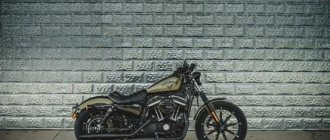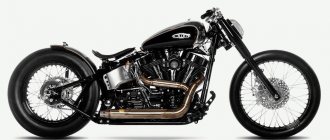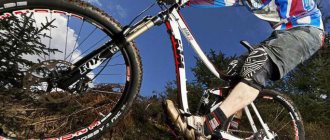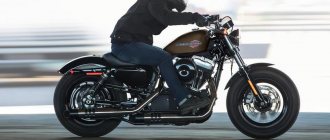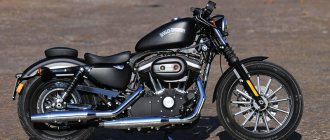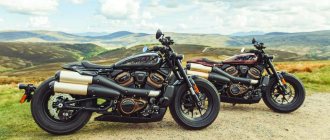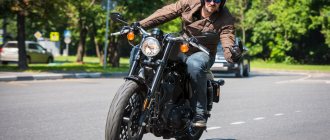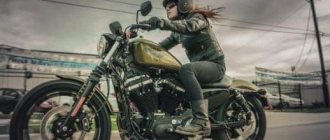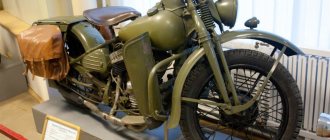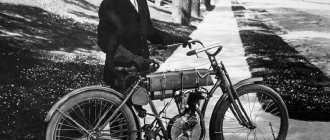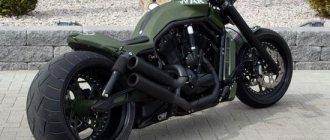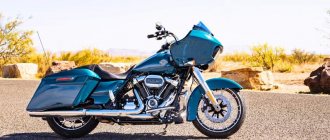Harley-Davidson motorcycle catalog
One of the oldest motorcycle companies in the world, founded in America in 1903, began with the idea of two young men to build a bicycle with a motor. The bike turned out not to be the most successful, so work on a new project began immediately after it. It can be called the first, real “Harley” - an engine with a volume of more than 400 cubic centimeters, a steel frame, the design of which was reminiscent of the Milwaukee Merkel mountain range. It was this prototype that debuted in the 1904 races, finishing with an excellent result for a new car . The company's first factory opened in 1906, and already in 1907 the company was producing 150 motorcycles a year. Single-cylinder motorcycles sold well, but the company did not stop there and showed the world a new, 2-cylinder motorcycle in 1908, which gained enormous popularity. By modernizing it in 1913, Harley Davidson became the largest American motorcycle manufacturer, overtaking Indian, which was dominant at that time. The First World War added to the popularity of the Americans - military orders poured in one after another, so by 1920 HD became the largest motorcycle manufacturer in the world, represented in 67 countries. In the 30s, against the backdrop of the Great Depression, the company was faced with a decline in demand, and, trying to stimulate it, it invented customization, offering customers to order a design on the tank, and in 1935 it sold a license for the production of motorcycles to the Japanese company Sankyo Company, which began assembling a licensed copy of HD called Rikuo. The Second World War again brought huge money and demand from the army, who needed more and more military motorcycles, so much so that the production of “civilian” vehicles had to be stopped altogether. But after the war, production was quickly demilitarized, and already in the 50s they showed a new product that became a real legend - the Sportster family. In the early 60s, the company surprised everyone with its scooter, and in 65 it showed the luxury tourer Electra Glide, which to this day is the flagship car of the brand. Since then, new models, now considered classics, have appeared like mushrooms after rain, but the main innovation, in addition to engines, was the abandonment of drive chains in favor of belts, and then, under the pressure of Japanese technology pouring into the American market, it successfully lobbied for an increase in import prices. duties to protect domestic production. In 1998, the company opened its first assembly plant outside the United States, in Brazil, and in 2001 the whole world was surprised by the neoclassic V-Rod, essentially founding a new class of power cruisers. And in 2013, the world was shaken by another piece of news - a new, small Harley with 500 and 750 cc engines, created for Asian markets, will be produced there, and not in the USA. In any case, today Harley-Davidson is one of the largest and oldest motorcycle manufacturers, having perhaps the most recognizable brand in the whole world and setting the standard in the classic motorcycle segment.
Harley-Davidson Iron 1200 test. Iron horse from the “tube” 1950s
In the mid-fifties of the last century, the first generation of Harley-Davidson Sportster motorcycles was born. Today, this family is undergoing more than its first modernization, but at the same time it remains, perhaps, the most faithful to the roots and traditions of all those bearing the nameplate of the American brand. So the HD Iron 1200 continues to live up to its name “iron” in 2021.
Egor Timofeev
Harley-Davidson Iron 1200 Price: from 943,000 rub. On sale: from 2021
When I first looked at the Harley-Davidson Iron 1200, it immediately occurred to me to call it a dude - its appearance reeks of the “tube” 1950s. Definitely, the styling of this bike is the main feature that everyone will notice. A single seat, a high handlebar, the so-called “uphanger”, footpegs located along the exhaust - all this, combined with white paint and blue-blue graphics on the tank, looks solid.
Unlike the previous version, in 2021 Iron received a new engine with a volume of 1200 cubic meters. Of course, this motor cannot be called new, because it has been produced practically unchanged for about 60 years. The only thing that has been improved is the injection - now it is electronic and has one nozzle. The character of the engine turned out to be quite “torque”; the engine loves higher speeds and even begins to work more smoothly at them.
Like all Harley-Davidson motorcycles, the Iron has a specific riding position. And here the usually inconvenient central location of the footpegs became a plus, because the suspension travel is not impressive. The suspension in general turned out to be quite oaky, and the footrests at least allow you to stand up on uneven surfaces and thus avoid blows to the spine.
Typically, motorcyclists use front brakes in most cases, but Iron's rear brakes were more effective. In general, it has no shortage of brakes if you use both at the same time.
The Harley-Davidson Iron is definitely a city motorcycle; long trips, due to its specific seating position, rigid suspension and lack of wind protection, are not its path at all. And controllability suffers due to small tilt angles, which, however, is typical for almost all Harleys - as soon as you’re about to tilt the motorcycle, you’re already scratching the footpegs on the asphalt. By the way, the centrally located running boards are quite dangerous: the metal pads wear off on the asphalt, become sharp, and you can injure your feet on them when you move them in a traffic jam. Although in general it is not difficult to get between the rows - the high uphanger steering wheel allows you to pass the mirrors of neighboring cars under the handles. But you have to sneak past crossovers especially carefully.
Motorcycles of the Sportster family are relatively inexpensive in the Harley-Davidson line, but along with the same Iron 1200 you purchase a ticket to the HOG party, that is, the opportunity to attend all the official events of the Harley-Davidson owners club in Russia and generally feel and be a full-fledged “Harleyist” . And although I, despite the company’s attempts in recent years to change its opinion about itself, still believe that HD are motorcycles for people over 40, the Iron 1200 is also suitable for the younger generation: for many today, a spectacular appearance is important, and the iron “Iron” “Effectiveness and brightness cannot be taken away.
Technical characteristics of Harley-Davidson Iron 1200
| Dimensions (length/saddle height) | 2200/735 mm |
| Base | 1515mm |
| Ground clearance | 110 mm. |
| Fuel tank volume) | 12.5 l. |
| Engine | 1202 cm3, 4‑stroke, 2‑cylinder V-shaped, air-cooled, 66/6000 l/min-1 |
| Transmission | mechanical, 5-speed, belt drive |
| Suspension (front/rear) | telescopic fork/pendulum with two shock absorbers |
| Brake (front/rear) | hydraulic disc with 2-piston caliper, 1 disc / 1 disc |
| Dry weight | 256 kg |
The editors recommend:
How to reduce washer fluid consumption?
Russians will be able to catch traffic violators on their phones
Where is it better to store a car - in a garage or outside? Opinions for and against
Advanced truck driver and savings on service: what do cargo carriers rely on?
New law: fine drivers for speeding 5 km/h
Discussion is closed.
I want to receive the most interesting articles
000_moto_0612_022
However, he is handsome. Along with the Knightster, which differs from the Iron only in a larger engine, spoked wheels instead of cast ones, a wider handlebar and a lower saddle, for me this is the most organic and visually balanced Sportster. Old-fashioned in appearance, painted matte black with nostalgic corrugations on the fork legs and minimal splashes of chrome, with an archaic lower air vent and a classic duplex frame made of thin pipes. Male. The company's designers, together with the retired "Willy G" Davidson, managed to put a polish on the classic lines and create an absolutely complete thing: just look at the laconic shape of the rear lights, which also combine the function of turn signals. There is not even a hint of the technocratism of the latest generations of motorcycles. Not the slightest. Of all the essential features of modernity, only disc brakes and fuel injection are the only ones.
However, do you really need something more to just go somewhere? Reason suggests no. Enough is enough! The most modest 53-horsepower Harley Evolution engine works, swaying in the depths of the frame on silent blocks, greedily gulping air and muttering hoarsely with a standard exhaust. When adding gas, the voice of the 45-degree “two” becomes deeper, as if rumbling at the bottom of a huge barrel, but remains just as quiet. The response to opening the throttle valve is blurry and borders on sluggishness: while the injectors inject the next portion of fuel into the throat of the combustion chamber, while the hefty flywheel spins up, an eternity passes. The craving does not flow in an uncontrollable, merciless stream, but is issued gradually, gently. What pisses off “fast guys” will suit phlegmatic natures, as well as those who are just taking their first “two-wheeled steps.” And the vibrations don't bother me. They are present in just the right amount to meet the expectations of brand supporters, and twice they practically dissolve somewhere in the middle speed range, when in fifth gear the speedometer measures 90 and 125 km/h.
And yet the Iron 883 is the same as other Harley Sportsters. Real, iron. However, it feels different. You sit a little higher than on the Custom, Seventy-Two or the similar Forty-Eight. The legs rest on the footpegs, located in the usual place for a “normal” motorcycle. The handlebars are wide, but low and closer to the fork crossbar. The forces on the clutch and brake levers at the end of the driving day do not bother your hands. Comfortable. Except for the mirrors, which reflect only your elbows, and whose short stands strongly advise you to refrain from wearing gloves with developed knuckle protection. Moreover, if not for the meager 12.5 liter tank, it would be possible to last more than 200 km in one sitting. In front of me I see nothing but the road and the lonely round speedometer with the overly optimistic number “220”, which is already clear! - the arrow will never reach. No matter how hard you try, the maximum comes noticeably earlier - at 168 km/h.
But to hell with it, at a speed of two hundred! Another thing is surprising: despite the horse-riding nature of the engine, it’s not that it’s impossible to ride fast on a “sporty” Harley - you don’t want to. At all. You parade along the city streets at a walking pace, sway slightly to the “beat” of the road profile, admire the surrounding landscape - and life is beautiful, and everything is fine. You can, of course, take a sharper turn or take a tighter turn on the highway, because compared to its direct competitors, the Sportster’s reactions to control actions seem unexpectedly prompt. It easily changes direction and moves steadily in an arc - not yet a sportbike, but already something. Although the Sportster Iron turns by touch, without bothering at all to provide the person behind the wheel with feedback.
The main thing here is not to overdo it. Because the first indication of misuse of the “American” is its modest ground clearance. And the striking running boards are not so bad, what’s worse is that almost simultaneously with them, beautiful chrome-plated mufflers (on the right) and a side stand (on the left) come into contact with the asphalt. And after this you notice that the soft suspension is simple to the point of disgrace and reacts to any potholes with a hard breakdown. Or that in fast corners the chassis begins to live its own life, and the brakes are sufficient to the extent that they are needed. Or that at speeds close to maximum, the Sporty requires increased attention in an unmanly way. And in other respects it is not a gift.
The corporate slogan tries to convince that the Sportster line is classic, speed and power. Classic? Yes, quite likely. But with speed and power, the company clearly got carried away. They are not here.
But despite all the shortcomings, I like the Harley Davidson Sportster Iron 883. Precisely because of its imperfection, simplicity and lack of newfangled, and often unnecessary, bells and whistles. Numerous shortcomings make the motorcycle... more alive, or something, more humane.
We have become spoiled. With the advent of assistive technologies - ABS, traction control, launch control, anti-wheelie, electronic gas - riding a motorcycle is gradually turning into a process that requires less and less participation from the pilot. Has it rained, has the quality of the road surface changed, or have you overdone the gas? By energetically winking the lamp on the instrument panel, the traction control will notify you that excess traction has been compensated. Do you need to stop urgently, but there is sand under your wheels? The driver learns about the intervention of the anti-lock braking system by itching on the brake levers. They taught you how to start in a motorcycle school, but you still haven’t mastered the skill of starting effectively? The electronics will set the speed itself and make sure that the front wheel does not rise too high. Man has become an appendage, a consumer.
And now, the “eight hundred and eighty-third” Sportster. It does not lull or corrupt with excessive comfort, as the big “Twins” from Milwaukee do. It is not overloaded with insurance electronic assistants. It looks like an old biplane. If an emergency situation arises, all responsibility falls on the shoulders of the person managing it. You need to make your own decisions. The pilot is the master of his own destiny.
Harley seems to have stopped developing many decades ago. “It is not the calendar manufacturers who give us the feeling of “our time,” today—it is the designers of cars, dishes, televisions, and fashion trendsetters who do this. Without a new car, time stands still,” wrote the American pilot and novelist Richard Bach. And the smallest “Sportster” is the spirit of “that time”, which was not lost in history books, did not turn into memories. He's here right now.
Harley Davidson Tri-Glide
It's interesting that Harley Davidson does not position the Tri-Glide as a device for those who are tired of driving two-wheeled vehicles. New (read: young) riders are interested in the Tri-Glide at the same rate as experienced ones. Harley Davidson says the CVO version of its trike has become "the most sought-after model in the history of Custom Vehicle Operations."
Why not? When you buy it, you get the latest hardware and software, including a special three-wheeled version of RDRS, Boom! Box with four columns of 75w, 192 liters of luggage capacity. And its curb weight is only 575 kg, that is, the third wheel adds only 180 kg to the weight of the two-wheeled Glide.
Winding roads are definitely not the Tri Glide's cup of tea, unless you're looking for a fun way to flip. But when driving in a straight line, you literally forget that you are on a trike. Well, of course, on a smooth straight line: on an uneven road, according to the apt observation of Peter Egan, the trike will definitely remember its main purpose - to let the rider feel all the bumps and holes.
That's it for the 2021 model year. Harley Davidson continues to chart its own course. In some cases we don't really like this course, but the FL series touring motorcycles are something unique in their kind, and there are no other models as balanced and at the same time characterful and charismatic as them.
003_moto_0612_022
The original oil cap, introduced in 2004 across the entire Sportster line, is a practical and elegant solution.
When closed, it is flush and opens by pressing. The original oil cap, introduced in 2004 across the entire Sportster line, is a practical and elegant solution. When closed, it is flush and opens by pressing.
006_moto_0612_022
Separate control of right and left turn signals is a constant feature of all Harley Davidsons.
In their desire to preserve them at all costs, the Americans are reminiscent of Mercedes and their “holy grail” - a single steering column switch. Separate control of right and left turn signals is a constant feature of all Harley Davidsons. In their desire to preserve them at all costs, the Americans are reminiscent of Mercedes and their “holy grail” - a single steering column switch.
